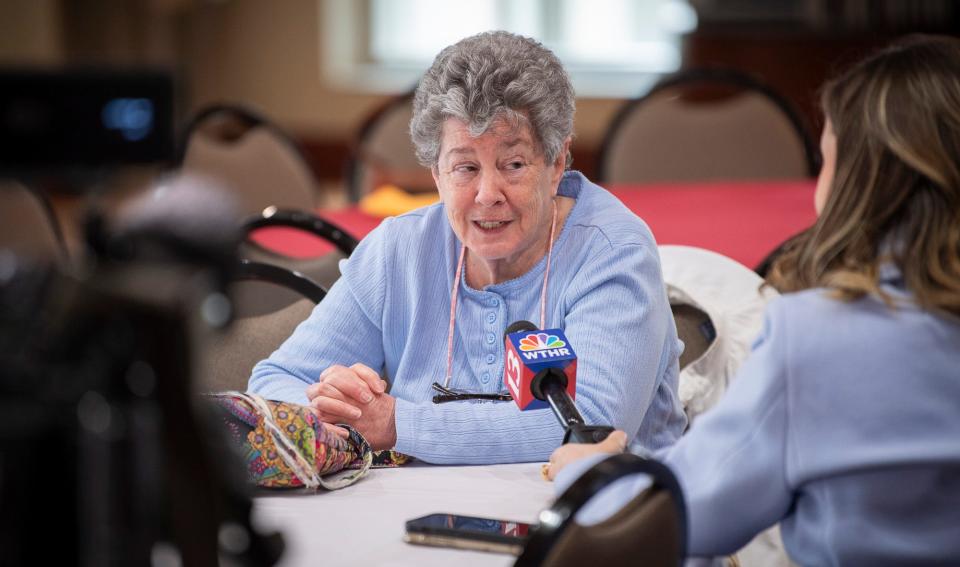Total eclipse 2024: 3 years of planning in Bloomington for 4 minutes of darkness
Some people living in the path of the April 8 total solar eclipse may be anxiously anticipating this once-in-a-lifetime opportunity to be center stage.
Others may be growing tired of hearing about the daytime darkness that will occur when the moon passes directly between the Earth and sun, projecting a shadow that will totally block the surface of the sun.
Visible to the eye and safe to view once the sun is completely blocked will be the explosive corona, the edge of the sun’s surface that may sparkle and flash during totality.
The 115-mile-wide path of total darkness will last between three and four-and-a-half minutes in each area as it travels across North America, leaving a return to daylight in its wake. Even if it's cloudy, the sky will go dark during the eclipse.
Optometry professor: OK to remove protective eyewear during totality

Indiana University optometrist Hin Cheung said he hopes eclipse watchers pay attention to warnings to not look directly at the sun until it is totally covered. Then, he said, people in and around Bloomington can remove their eclipse glasses and protective viewers and spend four minutes gazing skyward at a celestial event they may never experience again.
“But the moment you see a small sliver of sunlight coming out, look away. Put the glasses back on,” he warned. What’s called solar retinopathy can result in life-long damage to a person’s sight.
Cheung said free solar viewers will be given out during the April 6 Science Fest event, held in eight locations across the IU campus the Saturday before the eclipse. There will be astronomers at welcome tables in Franklin Hall and at the nearby Kirkwood Observatory for eclipse-related inquiries.
2024 eclipse will be 'an amazing experience'
While most humans will be aware of what’s happening, animals will be clueless. “Chickens will go home to roost, then come out again four minutes later expecting breakfast,” IU astronomy professor Caty Pilachowski said.

The veteran astronomer is among those counting the days until the eclipse, which she said will be “an amazing experience” for citizen viewers.
And from a scientific perspective, the event will be “very significant,” she said, a rare chance for scientists to get a good look at the solar corona and atmospheric gases that surround the sun.
In the 18th century, an eclipse was the only time scientists could study the gases that extend millions of miles beyond the sun. The same is true today. “It’s still the only way to study the solar corona close to the sun,” Pilachowski said.
A 1919 total solar eclipse verified Einstein’s theory of general relativity, she said, by showing how stars changing positions proves that gravity bends light beams.
The scientist in her is aware of a special magic that a total eclipse can evoke which transcends boiling-hot gases and learning more about the sun.
“There can be an unbelievable emotional response, a connection people feel to nature and to the universe,” Pilachowski said. And the best place to experience that if you are in the solar eclipse path? “Your backyard, where you can be the most captive audience.”
She said 30 special solar telescopes set up in the path of total darkness from Texas to New England will record and provide livestreamed images of the eclipse as it travels across the United States. The images can be viewed live by downloading an app called “Totality,” a collaboration between the American Astronomical Society and Big Kid Science.
“I am looking forward to the movie,” Pilachowski said during a recent IU news media event outlining the university’s plans.
IU’s Kirkwood Observatory will be open during the eclipse with telescopes set up for viewing and the cross-country livestream will be on screen to watch.
April 8 solar eclipse in Bloomington times and other facts
Expected visitors to Bloomington: about 300,000
Time the eclipse will begin in Bloomington: 1:49 p.m.
Time total darkness starts: 3:04 p.m.
Time total darkness ends: 3:08 p.m.
Time of totality: 4 minutes, 3 seconds
Time eclipse ends: 4:26 p.m.
IU campuses in the path of the total eclipse: 6
First aid and information stations at IU-Bloomington: 3
Portable bathrooms around the IU-Bloomington campus: 100+
Subcommittees at IU dedicated to eclipse planning: 18
Number of years IU public safety officials planned: 3
Number of scenario-based exercises for police: 4
Number of IU-Bloomington police officers on duty: 65
Number of Bloomington police officers on duty: 80
Number of IU optometry school free solar viewers: 3,000
Number of special solar telescopes tracking the U.S. event: 30
Longest time of totality (Mexico): 4 minutes 28 seconds
The next total solar eclipse visible in the U.S.: Aug. 23, 2044.
Contact H-T reporter Laura Lane at llane@heraldt.com or 812-318-5967.
This article originally appeared on The Herald-Times: Things you may not know about the 2024 total solar eclipse in Bloomington

